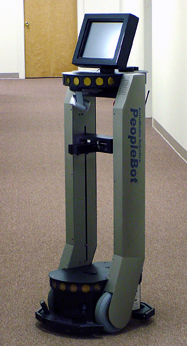This is an old revision of the document!
Table of Contents
Visiting The Robot House
Don't you wonder sometimes, just like I do, about how would it really be and feel like when robots would be in a social space or a household? Will it be a different experience from when interacting with robots in exhibitions, academic or business premises? I believe that the experience will involve various novel confused feelings. However, all guessing won't offer a solid basis for any kind of knowledge. So let's see how visiting a robot house would reveal some of the truth about it, which is the right place to answer these kinds of questions.
It sounds as if it is a place where you go and visit a robot's family. However that is still an ambitious interpretation to think of. In fact, Robot House is an ordinary British style flat that was used by LIREC research team to run Human Robot Interaction (HRI) experiments to test how participants would feel and react towards robots in certain situations [1]. In this house the host is a robot from the PeopleBots with a tray that fetches snacks to you whenever you like.
The Idea of the “Robot House”
To know what is people's perspective about robots in terms of having social relationships with them, certain methods and experiments have to be performed to collect data. For this reason the Robot House was started. The house idea came from the fact that apparently, the physical space plays a role in a way that it psychologically affects the comfort of the subjects. Because when trials took place in the premises of a university or a lab, the participants felt that they are being watched or judged for their thoughts, ideas and reactions. A neutral space would avoid having these types of confusions. It would allow subjects to feel more relaxed and not obsessed with the idea that they are being watched. Leading to more accurate results instead of ambiguous results from subjects reacting in a way they should follow.
In this two rooms house, the HRI experiments took place in two experimentation styles: Live HRI and Video HRI to investigate more in the participants' point of views for interacting with robots and how domestic robots can be useful and efficient in order to well integrate them into society.
A Robot House and a Video Interaction?
Human-robot experiments involve working with medium or large human-scaled mobile robots in rather big spaces with considerable resources of hardware and human researchers and experimenters. This might pose some limitations to run consecutive experiments in HRI. To overcome some of the limitations of running live HRI experiments, a video approach is used instead. Experiments show that there is no significant difference between reacting with personality that is present or remote in a video [2]. Human subjects react the same way to virtual human characters and real humans when it comes to proxemics and distances[3]. Even children when involved in this type of experiment they get emotionally connected with virtual cartoon-like characters [4].
The VHRI setting replaces the real robot in the experiment into a character in a video footage. This video is displayed to participants who in turn will react to it. With the possibility to show it to a large number of participants at once; this method offers many advantages over the live HRI experimentation method. The repeating of the experiment with exactly the same scenario is very simple and effortless. Moreover, when editing the scenario is needed to include some of the participant point of views about it, just editing and adding some scenes to the video could easily do it.
Next, we discuss the live and video HRI experiments in the robot house in details.
The Live HRI Experiment
In the Robot House and at the beginning, subjects were introduced to the general work and HRI by watching a video about it. Afterwards the subject would enter the living room for the live HRI experiment [5] and sit according to one of the following scenarios: 1) Seated on a chair in the middle of an open space. 2) Standing in the middle of an open space. 3) Seated at a table in the middle of an open space. 4) Standing with their back against a wall.
The hosting robot would approach the subject from different directions holding a snack. The approach directions are: 1- Front (F) 2- Front-Left (FL) 3- Front-Right (FR) 4- Rear-Left (RL) 5- Rear-Right (RR)
The robot could only approach from where it is possible according to the current subject's physical position. When the subject is standing against a wall, it is certain that the robot won't approach from the rear directions unless it is a robot with super powers to walk through walls, which is not the case and won't be if we are robot-cargo-cult-free, or else it will be only in our imagination.
Interestingly and unsurprisingly, the polite robot knew that it should stop at a distance of 50 cm before approaching the subject, in order not to violate the intimate social space zone of humans.
The Video HRI Experiment
In another room in the Robot House the VHRI experiments took place. Subjects sat in front of a projection screen and watched short videos. First video played was for a female actor in one of the four position scenarios mentioned before. Then another video is played for the same actor and the robot approaching her from different directions bringing her a snack.
End of the Visit
These two experiments were intended to see what the most preferred approach direction and what the least preferred approach direction would be for the subjects [6]. Also to inspect if there would be any difference between the live and the video setting. At the end there were no differences. The ratings were relatively equivalent for both styles.
Regarding the subjects' preference of the approach direction, it was as follows:


